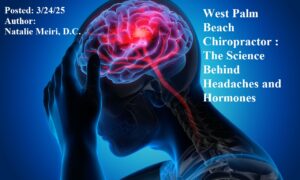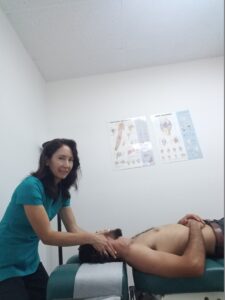
Evidence suggests that chiropractic care, including spinal manipulation, improves migraine and cervicogenic headaches. However, researchers have many theories. There are studies to explain beyond the “vascular dilation” and “muscle contraction” theories. This post is about West Palm Beach Chiropractor: The Science Behind Headaches and Hormones, Part III of the Headache blogs.
West Palm Beach Chiropractor: The Science Behind Headaches and Hormones and Women
Hormones influence the nerve cells that react to increases in serotonin and “natural opioids” (natural pain-relieving substances). The concentration of levels of serotonin in the blood (plasma levels) have been found to increase significantly in women experiencing headaches. Specifically, migraine with aura (sensory disturbances) and those with tension-type headaches are effected. Interestingly, this increase was not seen in women with migraine without aura.
Migraines during menstruation seems to occur due to “estrogen withdrawal/imbalance”. A high percent of migraine attacks in women are associated with menstruation. With pregnancy, there is an increased level of estrogen. Subsequently, with menopause, there is a decreased level of estrogen. These changes show a pattern in headache manifestations. For example, migraine sufferers typically improve during pregnancy, especially after the first trimester. Moreover, this improvement is suspected to be related to sustained high levels of estrogen.
However, migraine prevalence definitely decreases with age. Nevertheless, menopause, however, may even trigger the onset or return of migraine. Again, some studies indicate that estrogen replacement therapy increases or exacerbates migraines. Accordingly, studies indicate estrogen alone or in combination with testosterone helps relieve migraine sufferers.

West Palm Beach Chiropractor: The Science Behind Headaches and Hormones and Menopause
How do menopause symptoms occur? After 12 months without menstruating, a woman is in menopause. The average age of menopause onset in the Unites States is 51.
Decreased circulating levels of estrogen with menopause appear to affect the central nervous system via the hypothalamus. The hypothalamus is a small but important area in the center of the brain between the pituitary gland and thalamus. It plays an important role in hormone production and helps to stimulate many important processes in the body. The hypothalamus controls body temperature, thirst, hunger, and other homeostatic systems. It is also involved in sleep and emotional activity.
So 95% of perimenopausal and menopausal women experience “hot flashes”. These flushing and sweating episodes are sudden in onset and last several minutes. A sensation of face and neck hotness extends to the front of the chest. The skin temperature may increase as much as 2-5° degrees more. Next, there may result wetting of clothing through excess perspiration. Physiologic responses that also occur include an increase in heart rate perceived sometimes as palpitations.
Furthermore, there may be symptoms of headache, dizziness, and nausea during the episodes. Many women have night sweats and also have difficulty falling asleep. And often awaken early without being able to fall back to sleep. Approximately 80% of women experience these episodes for more than 1 year. And as many as 20% of women have symptoms for more than 5 years.
Menopause and Joint Pain Leading to Cervicogenic Headaches
A common symptom often associated with hormonal changes is pain. More than half of women experience Arthralgia (pain in a joint) around the time of menopause. The causes of joint pain in postmenopausal women can be difficult to determine. This is because the period of menopause coincides with a rising incidence of chronic rheumatic conditions such as osteoarthritis. Nevertheless, the prevalence of arthralgia does appear to increase in women going through menopausal transition. Studies have shown this to result from reduction in estrogen levels. This may have to do with various interactions between sex hormones and pain processing pathways, immune cells and chondrocytes (cartilage cells).
Given a growing concern regarding estrogen replacement therapy, a search for alternatives in the management of menopause is prevalent. Many studies have found that the use of alternative therapies for menopause symptoms is common. And women who use them generally find them to be beneficial. Chiropractic intervention in the treatment of postmenopausal climacteric symptoms especially in the area of joint pain and headaches is effective.

Chiropractor West Palm Beach: Treatment at Meiri Chiropractic for Headaches
Our spectrum of therapies at Meiri Chiropractic including adjustments, soft tissue techniques and therapeutic exercises (stretching and strengthening) will get you feeling better!
Your chiropractor will examine, diagnose and determine your best course of chiropractic treatment for headaches. Call us in West Palm Beach at 561-253-8984 to schedule an appointment or to find out more about West Palm Beach Chiropractor: The Science Behind Headaches and Hormones.
References:
Thomas Souza, (2018) Differential Diagnosis and Management for the Chiropractor